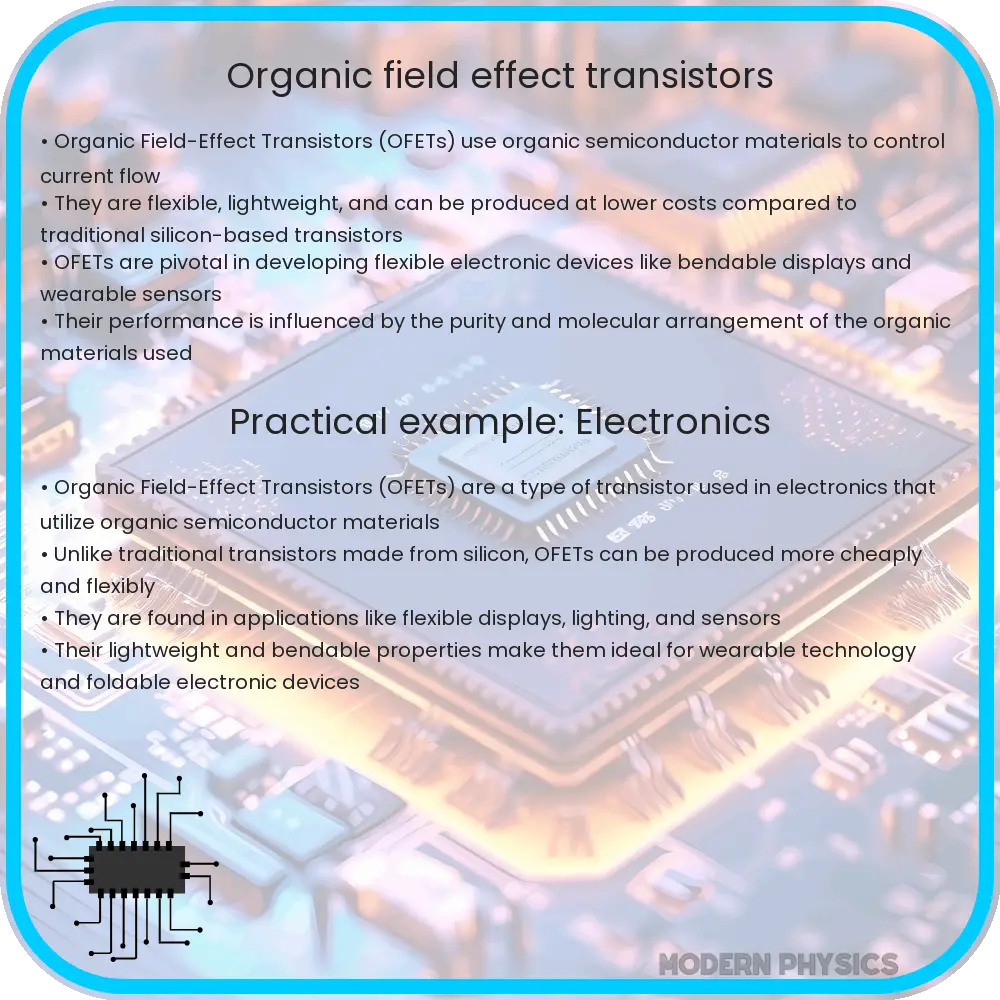Organic Field-Effect Transistors (OFETs) utilize organic semiconductor materials to enable flexible, cost-effective, and innovative electronic devices.

Understanding Organic Field-Effect Transistors: Efficiency, Flexibility, and Innovation
Organic Field-Effect Transistors (OFETs) represent a remarkable fusion of organic chemistry and semiconductor technology, offering potential advancements in flexible electronics and low-cost, large-area devices. Understanding the efficiency, flexibility, and innovative applications of OFETs is essential for appreciating their role in future electronic devices.
What are Organic Field-Effect Transistors?
At their core, OFETs are a type of field-effect transistor (FET) that utilize organic semiconductor materials instead of inorganic compounds like silicon. These organic materials are primarily small molecules or polymers that can conduct electricity. OFETs typically comprise three main components: the gate, the dielectric, and the semiconductor layer, which are assembled on a substrate that can be as flexible as plastic or paper.
Efficiency of OFETs
Efficiency in OFETs is often gauged by their charge carrier mobility, which measures how quickly charge carriers (such as electrons or holes) can move through the semiconductor under the influence of an electric field. While traditional silicon-based transistors have higher mobility, advancements in organic semiconductors have seen significant improvements in OFET performance. Factors contributing to this include the purity of organic materials, the molecular arrangement within the semiconductor, and the optimization of device structure.
Flexibility and Form Factor
One of the standout features of OFETs is their inherent flexibility. Unlike rigid silicon wafers, organic materials can be deposited on flexible substrates, enabling the creation of bendable and even rollable electronics. This flexibility opens up new applications in wearable devices, flexible screens, and even ‘smart’ textiles that can monitor health or environmental parameters. The lightweight and thin format of OFETs further enhances their appeal in these innovative fields.
Innovative Applications of OFETs
- Flexible Displays: OFETs are being developed for use in flexible OLED displays that could be used in everything from foldable smartphones to roll-up televisions.
- Wearable Technology: With their light weight and flexibility, OFETs are ideal for integrating into clothing or wearable devices that need to conform to the contours of the human body.
- Sensors: OFETs can be engineered to detect various physical, chemical, and biological substances, which makes them useful in environmental monitoring and medical diagnostics.
- Low-Cost Electronics: The materials and manufacturing processes involved in producing OFETs can be less expensive than those for silicon-based electronics, offering a cost-effective solution for various applications including RFID tags and disposable sensors.
The integration of OFETs in these areas highlights not only their flexibility and efficiency but also their transformative role in enabling new design paradigms for electronic devices.
Challenges and Future Prospects
Despite their potential, OFETs face several challenges that need to be addressed to maximize their practicality in commercial applications. The longevity and stability of organic materials under different environmental conditions, such as exposure to heat, moisture, and UV light, are some of the primary concerns. Further, enhancing the electrical performance and ensuring consistent reproducibility are crucial for their widespread adoption.
Continued research and development are focusing on overcoming these challenges by improving the molecular design of organic materials, exploring new polymer structures, and optimizing device architecture. The future of OFETs lies in the ability to combine flexibility, cost-effectiveness, and enhanced performance, making them integral to the next generation of electronic devices.
Materials and Fabrication Techniques
The progress in OFET technology heavily depends on advancements in material science and innovative fabrication methods. Organic materials used in OFETs are synthesized to have high purity and structural perfection to enhance performance. Techniques like vacuum deposition, inkjet printing, and spin-coating are employed to layer these materials precisely on substrates. Each method offers distinct advantages in terms of efficiency, cost, and suitability for different applications, influencing how OFETs can be scaled for mass production and commercial use.
Environmental Impact and Sustainability
OFETs not only promise improvement in device flexibilities and cost but also present an environmentally friendlier alternative to conventional electronics. The use of organic materials, which are often carbon-based and more readily degradable than inorganic materials, could reduce electronic waste and lower the environmental footprint of device manufacturing. Furthermore, the ability to process OFETs at lower temperatures than silicon-based electronics results in a significant reduction in energy consumption during fabrication.
Educational and Research Opportunities
The development of OFETs also opens paths in academics and research, encouraging interdisciplinary collaboration. Universities and research institutions worldwide are exploring the applications and limitations of OFETs, pushing forward the boundaries of what can be achieved. Such environments provide students and researchers with opportunities to contribute to real-world applications and innovations, bridging the gap between theoretical knowledge and practical engineering.
Conclusion
Organic Field-Effect Transistors stand at the junction of multiple technological paths, from advancements in organic chemistry and materials science to groundbreaking applications in flexible and wearable electronics. Despite the challenges posed by the stability and longevity of organic materials, continuing research aims to harness and enhance the potentials of OFETs. The implications of these developments are vast, offering a glimpse into a future where electronics are more integrated into our daily lives, more adaptable to our needs, and more in harmony with our environment. As research progresses, OFETs will increasingly become a staple of technological innovation, potentially transforming the landscape of electronics design and application in profound ways.
